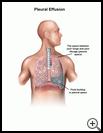
Pleural Effusion
________________________________________________________________________
KEY POINTS
- Pleural effusion is a buildup of fluid in the space between your lungs and your ribcage (pleural space). The fluid buildup makes it hard for your lungs to expand when you breathe.
- You may need a procedure or surgery to drain the area or to get a sample of tissue for diagnosis of the cause. You may need to stay in the hospital.
- Ask your healthcare provider how and when you will hear your test results and how long it will take to recover.
________________________________________________________________________
What is pleural effusion?
Pleural effusion is a buildup of fluid in the space between your lungs and your ribcage (pleural space). The fluid buildup makes it hard for your lungs to expand when you breathe. If you can't breathe normally, your body may not get enough oxygen to work properly.
What is the cause?
Many conditions can cause extra fluid to build up in the pleural space. The most common causes include:
- Lung infections, such as pneumonia or tuberculosis
- Heart failure
- Liver or kidney disease
- Cancer
- A blood clot that blocks an artery in your lungs
What are the symptoms?
Symptoms may include:
- Chest pain
- Shortness of breath
- Fever
How is it diagnosed?
Your healthcare provider will ask about your symptoms and medical history and examine you.
Tests may include:
- Chest X-rays
- Ultrasound scan, which uses sound waves to show pictures of the chest
- CT scan, which uses X-rays and a computer to show detailed pictures of your chest
- Thoracentesis, which uses a needle inserted through a space between your ribs to draw out fluid from your lung. The fluid can be tested for problems, such as infection.
- A biopsy, which is the removal of a small sample of lung tissue for testing
How is it treated?
The fluid buildup can be removed in different ways, such as:
- Thoracentesis, which uses a needle inserted through a space between your ribs to draw out fluid or air. You will feel some immediate relief, but it may take several days for your lung to completely fill with air again.
- A chest tube, which is a flexible tube inserted between your ribs into your chest. Suction is often used to help drain fluid and air from the space between your rib cage and lungs.
These procedures are usually done in the hospital, often in the emergency room. You may need to stay in the hospital for several days after these procedures. Your provider will also treat the condition that caused the fluid buildup. In some cases, you may need to see a specialist, such as a lung doctor (pulmonologist).
You may need surgery to drain the area or to get a sample of tissue for diagnosis.
You may need to stay in the hospital if:
- There is pus in the fluid
- You have severe trouble breathing
- You have a lot of pain
You will also stay at the hospital if you are at risk for:
- Lung swelling and irritation
- Severe heart failure
- A blood clot
- Liver failure
How can I take care of myself?
Ask your healthcare provider:
- How and when you will get your test results
- How long it will take to recover
- If there are activities you should avoid and when you can return to your normal activities
- How to take care of yourself at home
- What symptoms or problems you should watch for and what to do if you have them
Make sure you know when you should come back for a checkup. Keep all appointments for provider visits or tests.

